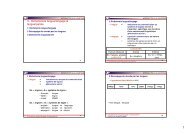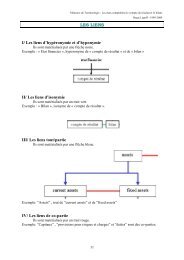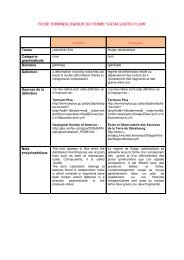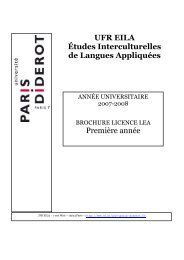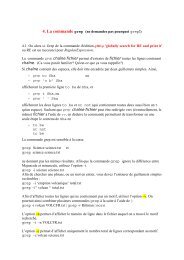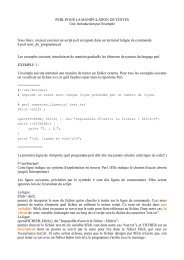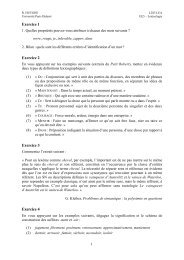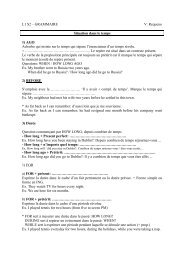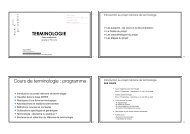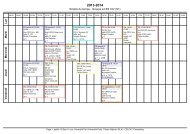INTRODUCTION TO ENGLISH TEXT LINGUISTICS
INTRODUCTION TO ENGLISH TEXT LINGUISTICS
INTRODUCTION TO ENGLISH TEXT LINGUISTICS
Create successful ePaper yourself
Turn your PDF publications into a flip-book with our unique Google optimized e-Paper software.
Professor Christopher Gledhill<br />
(Notes de cours, Linguistique du texte anglais, 48LGAN23, EILA, Université Paris Diderot)<br />
collocations’, it is possible to make a further distinction between ‘free’, ‘semi-fixed’ and ‘fixed’<br />
collocations. Free collocations involve the co-selection of two or more lexical items within the<br />
same structure (clause, phrase, group). Free collocations are productive constructions in the<br />
language, and it is usually possible to list several possible variant collocates 10 for any one<br />
construction (such as ask + a favour, a question, the way, make + love, peace, sense, set + free, sail,<br />
store, etc.). Semi-fixed collocations involve the co-selection of lexical items whose meanings often<br />
complement each other, with one word being the main point of reference or ‘base’ (thus in auburn<br />
hair, rancid butter, torrential rain: hair, butter and rain are the ‘bases’.) Fixed collocations involve<br />
sequences which co-occur so predictably that they have become a fixed or ‘lexicalised’ as a single<br />
highly predictable unit (such as nowadays, so to speak, curry favour etc.). A number of fixed<br />
collocations are also made up of closed-class ‘grammatical’ words (of course, so be it, more or less,<br />
ups and downs, etc.). This latter type of collocation is is known as a ‘lexical phrase’ and has an<br />
important role to play in how texts are composed.<br />
Exercise 4a<br />
a) Identify the Phraseological Units (PU) in the following 25 examples (if just part of the PU is<br />
involved, underline the relevant words).<br />
b) Identify the type of PU (idiom, proverb, fixed collocation, free collocation, etc.)<br />
c) State whether the PU is productive or unproductive (i.e. does it allow variations of words or<br />
structure?)<br />
d) State whether the PU is predictable or unpredictable (i.e. can its habitual meaning or use be<br />
predicted from its component words?).<br />
e) State whether the PU is marked or unmarked (i.e. is it associated with a particular<br />
communicative function or context, e.g. How do you do, Yours sincerely... etc.)<br />
f) Translate the example into French. Does the translation use an equivalent PU or some other<br />
construction?<br />
1. Come on, spill the<br />
beans!<br />
2. Absence makes the<br />
heart grow fonder.<br />
3. Bless you!<br />
Type of PU Lexicogrammar<br />
(productive /<br />
unproductive?)<br />
Semantics<br />
(predictable /<br />
unpredictable?)<br />
Context<br />
(universal /<br />
unique?)<br />
10 Note that when two (or more) items are used in a collocation, linguists sometimes say that they ‘collocate’<br />
together (accent on the final syllable), and that the words involved are ‘collocates’ (accent on the first syllable).<br />
25 / 37




